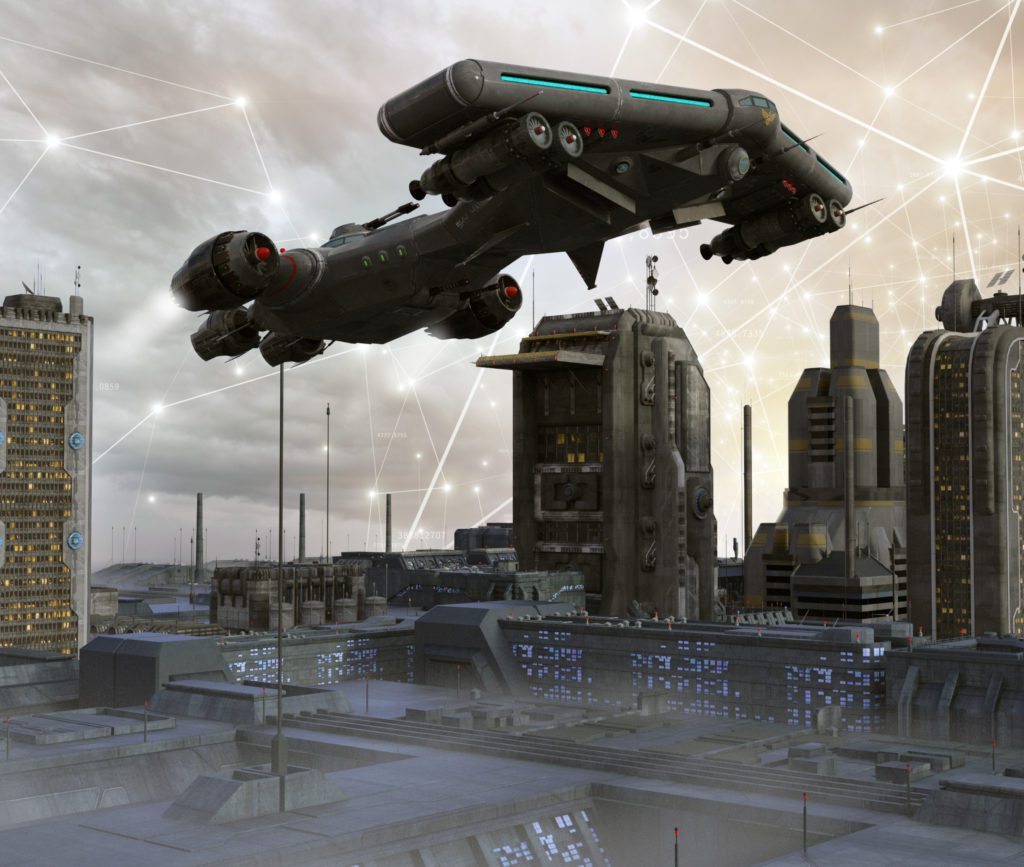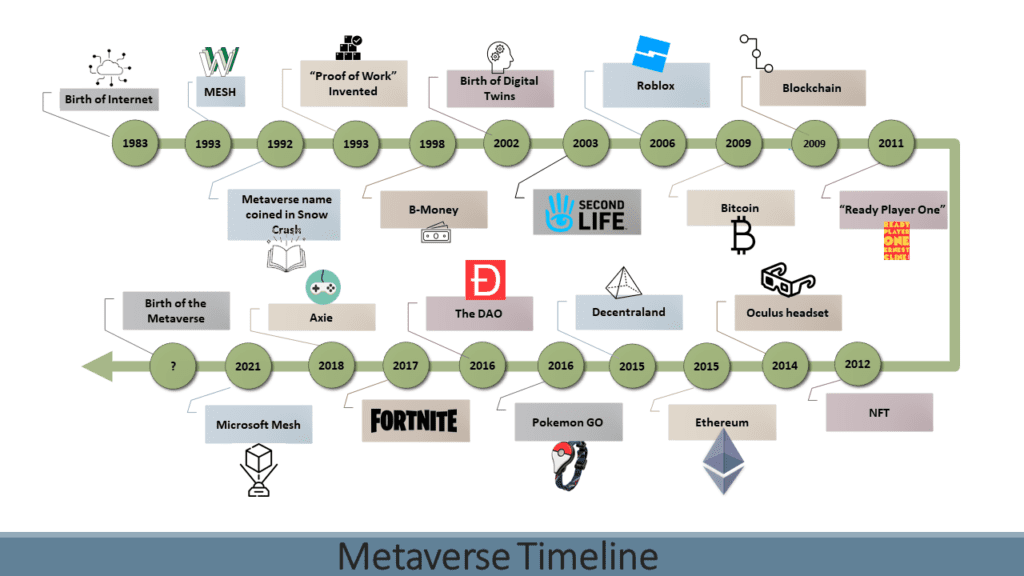
The metaverse has recently come to the forefront of the internet, especially in online gaming, but it’s not a new idea. The concept has been developing for decades, shortly after the internet was born. The above image is based on one I came across in an article on AI in the Metaverse [1]. Working from the original image, I researched the facts and tweaked the entries a little, making a few small changes. For example, I disagreed that Meta/FB should be on the timeline at all, as Meta’s plan is yet to come to fruition. The result is a timeline of the metaverse from 1983 to present day.

Timeline of the Metaverse (1983 to Today).
1983: Birth of the internet. The article Artificial Intelligence for the Metaverse: A Survey listed 1993 as the birth of the internet, which is not the generally accepted date; January 1, 1983 is considered the official birthday of the Internet because that’s when Transfer Control Protocol/Internetwork Protocol (TCP/IP) was released, enabling computer networks to “talk” to each other [2].
1993: The first web-browser, Mesh, was released [3].
1992: Metaverse name coined in Snow Crash , written by Neal Stephenson [4].
1993: Proof-of-Work invented by Cynthia Dwork and Moni Naor. In a nutshell, PoW expends energy to verify cryptocurrency [5].
1998: B-money arrives. B-money is the first system where all transactions are publicly (but anonymously) broadcast [6].
2002: Digital twins. Dr. Grieves, an expert in Product Lifecycle Management introduced the digital twin concept for designing, testing, manufacturing and supporting products in the virtual world [7].
2003: Second life is launched. SL is an “immersive, three-dimensional (3D) environment that supports a high level of social networking and interaction with information” [8]. Second Life may be the first instance of a large-scale, metaverse-type world.
2006: Roblox is released. The gaming platform has been described as a “proto-Metaverse with a path to the Metaverse” foundational elements for the metaverse including immersive experiences, avatars that persist across games, and a digital economy [9].
2009: Bitcoin becomes the first cryptocurrency, which “transformed the way we think about money” [10].
2009: Blockchain initial code is launched. Nakamoto created the cryptocurrency to be a form of peer-to-peer cash that could be sent without the need for a central authority to operate and maintain the ledger [11].
2011: Ready Player One,a novel by Ernest Cline, is released. RPO went on to inspire “real” VR. Cline is quoted as saying “What’s really astounding to me is a lot of the guys at Oculus VR and other companies who were creating VR tell me that Ready Player One is one of their primary inspirations in getting into virtual reality,” [12].
2012: NFTs emerge from a “colored coin”, initially issued on the Bitcoin blockchain [13].
2014: Facebook buys Oculus, a VR headset that has already revolutionized games. Facebook/Meta promises the headset will “revolutionize digital social interaction, and after that, the world.”[14].
2015: The advent of Etheruem, a blockchain designed to make cryptocurrency and allow people to build decentralized applications [15].
2015: Decentraland released. Described as “a metaverse, a social 3D world with a native economic network. The goal of Founder Esteban Ordanois to have a self-contained economy where people can rent land, place billboards, and create gathering places [16].
2016: Pokemon GO had millions of people roaming around to catch characters. One of the first games to merge digital and physical worlds, it took augmented reality (AR) from niche to mainstream [17].
2016: The DAO launched by German startup slock.it. A great success of the time, “decentralized version of Airbnb” raised over $150 million worth of Ethereum in a crowdfunding campaign [18].
2017: Fortnite released. All of Epic Games’ titles are connected, which was “an ingenious way of integrating one game after the other,“ [19].
2018: Axie Infinity, developed by the Sky Mavis company, is a blockchain-based war game which includes complex player-owned economies and rewards [20].
2021: Microsoft Mesh. Unlike Facebook’s (sorry, Meta’s) metaverse concept, Microsoft’s new mixed reality platform has become reality, albeit in a “limited free preview” form. The tech will allow team from different geographic locations to meet and collaborate shared AR [21].
References
[1] Artificial Intelligence for the Metaverse: A Survey
[2] World Wide Web (WWW) launches in the public domain
[3] A Brief History of the Internet – University System of Georgia
[4] He conceived of the Metaverse in the ‘90s. He’s unimpressed with Mark Zuckerberg’s.
[5] An Analysis of the Cryptocurrency Industry
[6] SoK: Research Perspectives and Challenges for Bitcoin and Cryptocurrencies
[7] Back-to-the-Future Concept Spurs Product Lifecycle Revolution
[8] 6 Lessons on the Future of the Metaverse
[9] Roblox is disruptive innovation
[10] The History of Bitcoin, the First Cryptocurrency
[11] History of blockchain | Technology | ICAEW
[12] How this author’s fictional world inspired real VR
[13] The History of NFTs & How They Got Started – Portion Blog
[14] Facebook Bought Oculus VR To Create The Metaverse, Or Why Angry Kickstarter Backers Need To Chill
[15] Ethereum Price History — Crypto Investing – TIME.
[17] How “Pokemon Go” Took Augmented Reality Mainstream
[18] What Are DAOs And Why You Should Pay Attention
[19] Epic Games ‘Metaverse’ Completes $1B Funding with $200M from Sony—Developers to Build a Digital Reality
https://blog.stcloudstate.edu/ims/tag/fortnite/
[20] Axie Infinity
[21] Microsoft Mesh powers shared experiences in mixed reality
